Digital Poster
Diffusion in Cancer
ISMRM & ISMRT Annual Meeting & Exhibition • 10-15 May 2025 • Honolulu, Hawai'i

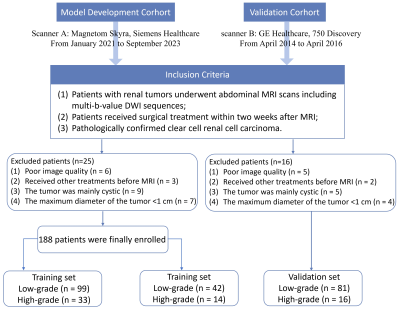 |
Computer Number: 65
2166. Predicting
Value of Multi-b-value DWI Models for Pathological Grading of
Clear Cell Renal Cell Carcinoma: A Multi-scanner Study
S. Li, M. Gao, Z. Zhou, Z. Li
Tongji Hospital, Tongji Medical College, Huazhong University of Science and Technology, Wuhan, China
Impact: This study provides valuable insights into the
utility of multi-b-value DWI models for grading ccRCC,
suggesting that advanced models offer limited additional
benefits over mono-exponential DWI. It enables more
efficient imaging choices and informs clinical
decision-making in ccRCC management.
|
|
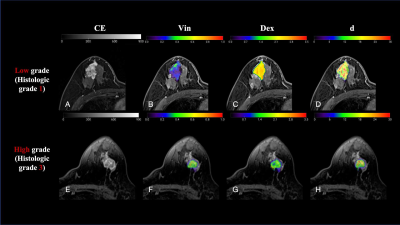 |
Computer Number: 66
2167. Differentiating
Histological grade in breast cancer by time-dependent diffusion
MRI: A Preliminary Study
S. Che, K. Ma, Y. Jiang, F. Thorsten, J. Li, X. Zhao, C.
Zhou
Cancer Hospital, Chinese Academy of Medical Sciences and Peking Union Medical College, Beijing, China
Impact: This study highlights time-dependent diffusion
MRI's potential for accurate, non-invasive breast cancer
grading, enhancing clinical decision-making and treatment
planning, and paving the way for further research into
microstructural changes and applications in other cancer
types.
|
|
 |
Computer Number: 67
2168. Time-dependent
diffusion MRI for grading uterine cervical carcinoma based on
whole tumor volume: A preliminary study
Q. Zhang, Y. Jiang, X. Yu, X. Zhao
Cancer Hospital, Chinese Academy of Medical Sciences and Peking Union Medical College, Beijing, China
Impact: Time-dependent diffusion MRI, as a non-invasive
technique, could provide cell microstructure parameters for
differentiating tumor grade of CC from a histological point
of view, which may further assist in
preoperative clinical decision-making and prognosis
prediction for CC.
|
|
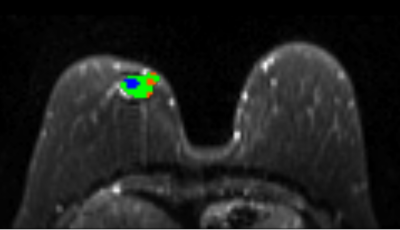 |
Computer Number: 68
2169. Characterizing
Tumor Habitats in Breast Cancer: A DKI Approach to Predicting
Estrogen Receptor Expression
H. Liu, Q. Wang, Z. Mao, H. Liu, M. Wang, Y. Song, C. zhang,
G. Yang
Department of Radiology, The Fourth Hospital of Hebei Medical University, Shijiazhuang, China
Impact:
This study demonstrates that diffusion kurtosis imaging can non-invasively predict estrogen receptor expression by characterizing tumor microenvironments, revealing significant relationships between tumor habitats and their microstructural properties. |
|
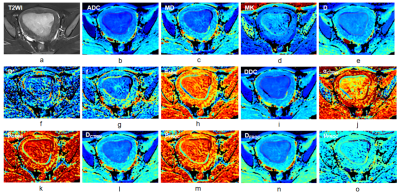 |
Computer Number: 69
2170. Differentiation
of early-stage endometrial carcinoma from benign endometrial
lesions: A comparative study of six diffusion models
Q. Bi, K. Wu, S. Wang, Y. Wu
The First People’s Hospital of Yunnan Province, Kunming, China
Impact: Together, diffusion parameters and the combined
model could become a new and non-invasive diagnostic
biomarker for differentiating benign and malignant
endometrial lesions.
|
|
 |
Computer Number: 70
2171. Oscillating
Gradient Diffusion-Weighted MRI For the Assessment of Breast
Lesions
W. Tang, Y. Guo, Z. Zhong, X. Xu, Y. Chen, Y. Xu, X. Wei
Guangzhou First People’s Hospital, Guangzhou, China
Impact: Oscillating gradient DWI, with shorter diffusion
times, complements conventional pulsed gradient DWI by
revealing additional tumor microstructural details. Combined
OGSE and PGSE sequences may enable novel diffusion-based
biomarkers for improved breast lesion characterization and
stratification.
|
|
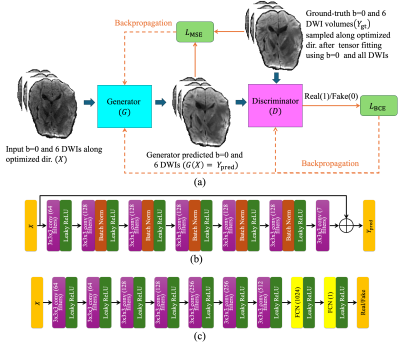 |
Computer Number: 71
2172. Generative
Adversarial Network (GAN)-based High-Fidelity Diffusion Tensor
Imaging in Brain Cancer Patients
I. Guha, H. Ravi, R. Mohamed, C. Quarles, H-L Liu
MD Anderson Cancer Center, Houston, United States
Impact: Our study demonstrates the potential of DL to
reduce DTI scan time for brain cancer patients by enabling
accurate estimation of DTI metrics from only 6-direction DWI
volumes; and enhancing their image quality and
signal-to-noise ratio.
|
|
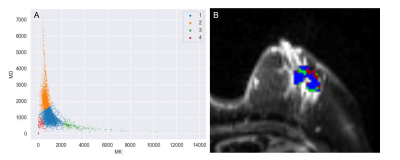 |
Computer Number: 72
2173. DKI-based
spatial heterogeneity analysis for tumor-infiltrating
lymphocytes level in breast cancer patients
Z. Mao, H. Liu, H. Liu, M. Wang, Y. Song, C. Zhang, G. Yang
The Fourth Hospital of Hebei Medical University, Shijiazhuang 050011, China
Impact: The stable predictive performance of DKI/TILs
can help clinicians make more accurate diagnoses;
commercialization is expected.
|
|
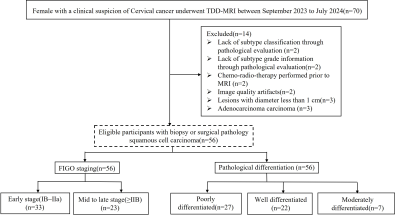 |
Computer Number: 73
2174. The
Application of Time-Dependent Diffusion MRI in Clinical Staging
and Pathological Differentiation of Cervical Squamous Carcinoma
J. j. Li, Y. Xiao, K. Ai, Y. Zhu, Y. Hao, J. Guo
The First Affiliated Hospital of Xi'an Jiaotong University , Xi’an, China
Impact: TDD-MRI parameters, particularly cell diameter,
demonstrate superior accuracy to ADC in differentiating
pathological grades and stages in CSC, supporting their use
for non-invasive cervical cancer assessment.
|
|
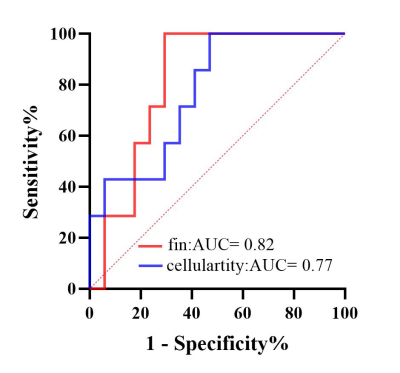 |
Computer Number: 74
2175. Time-Dependent
Diffusion MRI-based Quantitative Multiparameters for
Preoperative Assessment of VETC in Hepatocellular Carcinoma
M. Li, L. Zhou, A. Abudulimu, H. Zhang, L. Qian, T.
Feiweier, W. Li
Xiangya Hospital, Central South University, Changsha, Hunan Province, China
Impact: Td-dMRI is a potential tool for evaluating VETC
status in HCC, which may contribute to the optimization of
personalized treatment strategies for patients with HCC,
thus leading to improved prognosis.
|
|
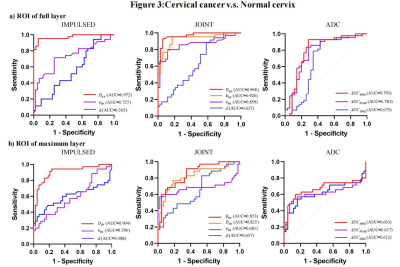 |
Computer Number: 75
2176. Optimizing
MRI Cytometry: Preliminary Applications and Standard Procedure
Enhancements in Cervical Cancer Diagnosis
Z. Yuan, D. Shi, F. Liu, Z. Wang, Y. He, X. Gao, Y. Li, J.
Chen, X. Liu, J. Ren, H. Guo, Z. Jin, H. Xue
Radiology Department, Peking Union Medical College Hospital, Beijing, China
Impact: The MRI cytometry parameters can distinguish
cervical cancer from normal cervix by directly capturing the
changes in the tissue microstructure. It may further assist
in preoperative risk stratification and treatment efficacy
evaluation in cervical cancer in the future.
|
|
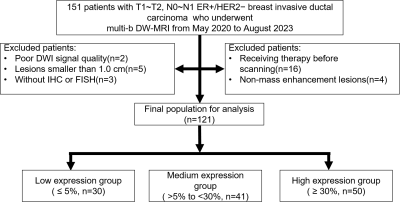 |
Computer Number: 76
2177. Distinguishing
Ki67 stratification expression in ER-positive/HER2-negative
breast cancers: comparison of advanced MRI diffusion models
Z. Kang, S. Du, L. Zhang
The Fourth Affiliated Hospital of China Medical University, Shenyang, China
Impact: This research reveals the utilization of FROC
model improved differentiation of the low Ki67 expression
group (Ki67≤ 5%) in ER+/HER2- breast cancer, who frequently
exhibit a favorable prognosis and do not require excessive
adjuvant chemotherapy.
|
|
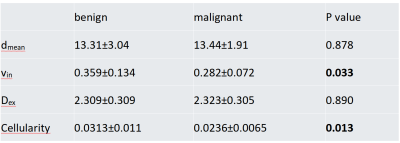 |
Computer Number: 77
2178. Detecting
Cellular Microstructural Changes of Bone Tumors with the
IMPULSED MRI
Y. Li, C. Ren, J. Cheng, Y. Zhang, W. Zhang, L. Lin
The First Affiliated Hospital of Zhengzhou University, Zhengzhou, China
Impact: This study revealed the changes in quantitative
microstructural mapping across the spectrum of bone tumors.
Intracellular volume fraction and cellularity are
potential markers for differentiating benign and malignant
bone tumors.
|
|
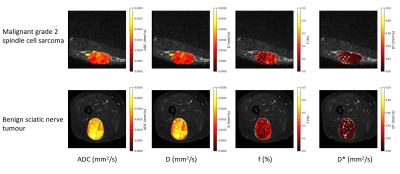 |
Computer Number: 78
2179. Evaluating
IVIM and ADC Parameters to Differentiate Benign and Malignant
Soft-Tissue Lesions
M. Marzetti, P. Robinson, L. Maguire, P. Duce, S. Klein, M.
Starmans, A. Scarsbrook, D. Buckley
Leeds Teaching Hospitals NHS Trust, Leeds, United Kingdom
Impact:
This work uses quantitative MRI to differentiate benign from malignant soft-tissue lesions, aiming to reduce the need for soft-tissue biopsies. This could reduce the number of invasive procedures patients undergo and provide diagnoses faster, reducing patient anxiety, pain and discomfort. |
|
 |
Computer Number: 79
2180. Characterization
of Upper Extremity Lymphedema Following Breast Cancer Treatment
Utilizing Diffusion Kurtosis MRI
Y. Lee, K-H Cho, C-H Tang, Y-C Chang, I-H Lee, Y-C Hsieh,
S-C Chao, C-H Kuan, L-W Kuo
National Taiwan University Hospital, Taipei, Taiwan
Impact: This study provides a quantitative approach to
delineate the tissue characteristics of lymphedema by
utilizing diffusion kurtosis MRI, enabling a more precise
and non-invasive way to assess the severity, which could be
potentially helpful to the surgical planning of lymphedema.
|
The International Society for Magnetic Resonance in Medicine is accredited by the Accreditation Council for Continuing Medical Education to provide continuing medical education for physicians.